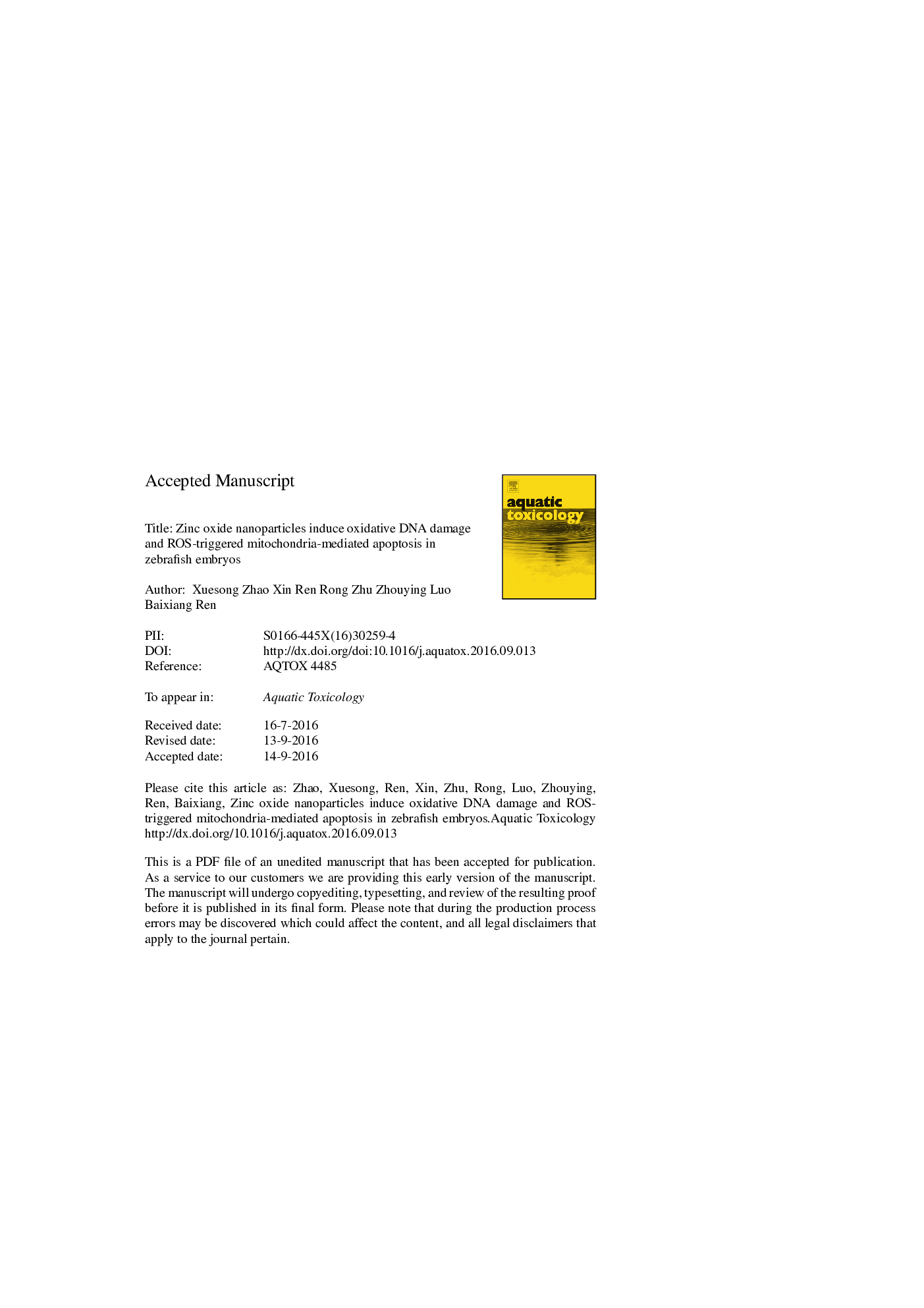| کد مقاله | کد نشریه | سال انتشار | مقاله انگلیسی | نسخه تمام متن |
|---|---|---|---|---|
| 6381808 | 1625925 | 2016 | 54 صفحه PDF | دانلود رایگان |
عنوان انگلیسی مقاله ISI
Zinc oxide nanoparticles induce oxidative DNA damage and ROS-triggered mitochondria-mediated apoptosis in zebrafish embryos
دانلود مقاله + سفارش ترجمه
دانلود مقاله ISI انگلیسی
رایگان برای ایرانیان
کلمات کلیدی
موضوعات مرتبط
علوم زیستی و بیوفناوری
علوم کشاورزی و بیولوژیک
علوم آبزیان
پیش نمایش صفحه اول مقاله

چکیده انگلیسی
Zinc oxide nanoparticles (nano-ZnO) are one of the most important nanoparticles in the industry. The objectives of this study were (1) to investigate the effects of nano-ZnO on oxidative damage to DNA and on apoptosis in zebrafish (Danio rerio) embryos, and (2) to identify the underlying molecular mechanism affecting theapoptotic process. In addition to nano-ZnO, we also investigated the toxic effects of the Zn2+ ion. Zebrafish embryos were exposed to 10, 30, 60, 90, or 120 mg/L nano-ZnO for 96 h postfertilization. Nano-ZnO (at concentrations between 10 and 120 mg/L) significantly reduced the rate of embryo hatching. Embryos/larvae exposed to 120 mg/L nano-ZnO had significantly higher heart rates. Increased heart rates could be a physiological mechanism compensating for body hypoxia. Embryos/larvae exposed to nano-ZnO exhibited oxidative stress, due to an excessive generation of reactive oxygen species (ROS). Oxidative stress was evidenced by increased levels of superoxide dismutase, by increased lipid peroxidation, and by increased expression of genes related to the antioxidant defense system (sod1, cat, gpx1a, and pparα), which were altered at different degrees. Upon exposure to nano-ZnO, the percentage of apoptotic cells increased in a dose-dependent manner (0.41% to 4.21%). In addition, altered transcriptional regulation of pro-apoptotic genes (bax, puma, and apaf-1) and anti-apoptotic genes (bcl-2) provided further evidence of the activation of apoptosis. In this study, exposure of zebrafish embryos to nano-ZnO triggered an excessive production of ROS, which was followed by several phenomena: the up-regulation of p53, a reduction in the bcl-2/bax ratio,a reduction in the mitochondrial membrane potential (Ïm), the release of cytochrome c into the cytosolic fraction, and the activation of caspases 9 and 3. Collectively, our data imply that nano-ZnO induce an excessive production of ROS which then activate the apoptosis pathway mediated by mitochondria and caspases.
ناشر
Database: Elsevier - ScienceDirect (ساینس دایرکت)
Journal: Aquatic Toxicology - Volume 180, November 2016, Pages 56-70
Journal: Aquatic Toxicology - Volume 180, November 2016, Pages 56-70
نویسندگان
Xuesong Zhao, Xin Ren, Rong Zhu, Zhouying Luo, Baixiang Ren,